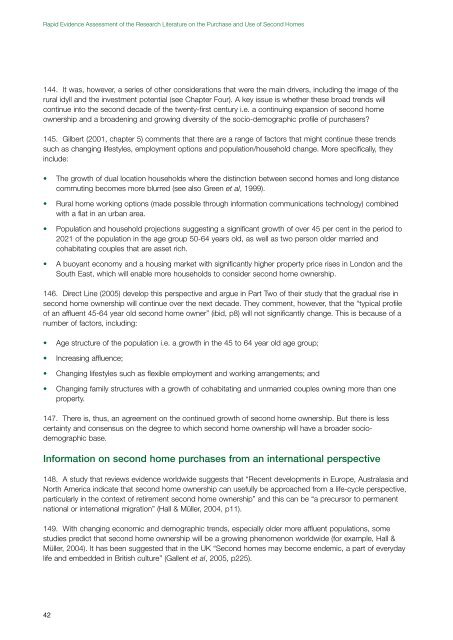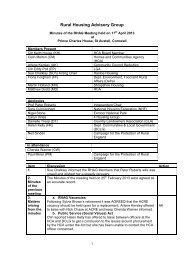Rapid Evidence Assessment of the Research ... - Rural Housing
Rapid Evidence Assessment of the Research ... - Rural Housing
Rapid Evidence Assessment of the Research ... - Rural Housing
Create successful ePaper yourself
Turn your PDF publications into a flip-book with our unique Google optimized e-Paper software.
<strong>Rapid</strong> <strong>Evidence</strong> <strong>Assessment</strong> <strong>of</strong> <strong>the</strong> <strong>Research</strong> Literature on <strong>the</strong> Purchase and Use <strong>of</strong> Second Homes<br />
144. It was, however, a series <strong>of</strong> o<strong>the</strong>r considerations that were <strong>the</strong> main drivers, including <strong>the</strong> image <strong>of</strong> <strong>the</strong><br />
rural idyll and <strong>the</strong> investment potential (see Chapter Four). A key issue is whe<strong>the</strong>r <strong>the</strong>se broad trends will<br />
continue into <strong>the</strong> second decade <strong>of</strong> <strong>the</strong> twenty-first century i.e. a continuing expansion <strong>of</strong> second home<br />
ownership and a broadening and growing diversity <strong>of</strong> <strong>the</strong> socio-demographic pr<strong>of</strong>ile <strong>of</strong> purchasers?<br />
145. Gilbert (2001, chapter 5) comments that <strong>the</strong>re are a range <strong>of</strong> factors that might continue <strong>the</strong>se trends<br />
such as changing lifestyles, employment options and population/household change. More specifically, <strong>the</strong>y<br />
include:<br />
• The growth <strong>of</strong> dual location households where <strong>the</strong> distinction between second homes and long distance<br />
commuting becomes more blurred (see also Green et al, 1999).<br />
• <strong>Rural</strong> home working options (made possible through information communications technology) combined<br />
with a flat in an urban area.<br />
• Population and household projections suggesting a significant growth <strong>of</strong> over 45 per cent in <strong>the</strong> period to<br />
2021 <strong>of</strong> <strong>the</strong> population in <strong>the</strong> age group 50-64 years old, as well as two person older married and<br />
cohabitating couples that are asset rich.<br />
• A buoyant economy and a housing market with significantly higher property price rises in London and <strong>the</strong><br />
South East, which will enable more households to consider second home ownership.<br />
146. Direct Line (2005) develop this perspective and argue in Part Two <strong>of</strong> <strong>the</strong>ir study that <strong>the</strong> gradual rise in<br />
second home ownership will continue over <strong>the</strong> next decade. They comment, however, that <strong>the</strong> “typical pr<strong>of</strong>ile<br />
<strong>of</strong> an affluent 45-64 year old second home owner” (ibid, p8) will not significantly change. This is because <strong>of</strong> a<br />
number <strong>of</strong> factors, including:<br />
• Age structure <strong>of</strong> <strong>the</strong> population i.e. a growth in <strong>the</strong> 45 to 64 year old age group;<br />
• Increasing affluence;<br />
• Changing lifestyles such as flexible employment and working arrangements; and<br />
• Changing family structures with a growth <strong>of</strong> cohabitating and unmarried couples owning more than one<br />
property.<br />
147. There is, thus, an agreement on <strong>the</strong> continued growth <strong>of</strong> second home ownership. But <strong>the</strong>re is less<br />
certainty and consensus on <strong>the</strong> degree to which second home ownership will have a broader sociodemographic<br />
base.<br />
Information on second home purchases from an international perspective<br />
148. A study that reviews evidence worldwide suggests that “Recent developments in Europe, Australasia and<br />
North America indicate that second home ownership can usefully be approached from a life-cycle perspective,<br />
particularly in <strong>the</strong> context <strong>of</strong> retirement second home ownership” and this can be “a precursor to permanent<br />
national or international migration” (Hall & Müller, 2004, p11).<br />
149. With changing economic and demographic trends, especially older more affluent populations, some<br />
studies predict that second home ownership will be a growing phenomenon worldwide (for example, Hall &<br />
Müller, 2004). It has been suggested that in <strong>the</strong> UK “Second homes may become endemic, a part <strong>of</strong> everyday<br />
life and embedded in British culture” (Gallent et al, 2005, p225).<br />
42






